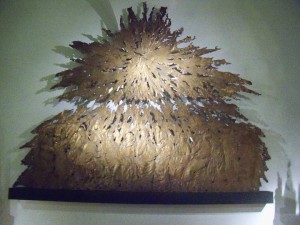Acts 2: 1-11
1 Cor 12:3b-7, 12-13 or Gal 5:16-25
Jn 20:19-23 or Jn 15:26-27; 16:12-15
My notion of Pentecost was forever changed eight years ago when I meandered my way through the Collection of Modern Religious Art in the Vatican Museum in Rome. As I entered one large room, I found myself flanked on either side by bronze figures from the Second Vatican Council. And leading the group of bishops at the front of each line was a man on his knees: Pope John XXIII on one side and Pope Paul VI on the other. Like all the conciliar figures on the left and the right, visitors to that room are transfixed by the bronze installation in the center: Pentecost. There, Mary and the disciples are soaked in the resplendent flames of the Holy Spirit.
Only when confronted with this dramatic depiction did I come to realize how very tame my images of Pentecost had been up until that moment – mostly a group of people in robes with a small birthday-candle-like flame hovering atop each of their heads. The presence of the Spirit was more like a subtle punctuation mark than an earth-shattering force of God. But thankfully this sculpture, “Pentecostale” by Lello Scorzelli, instantly transformed those feeble tongues of flames into an invigorating mouth of fire that consumed and enlivened. No photo could ever come close to doing justice to this piece, but until you can get to Rome, you can see the artwork here and here.
The vigor and intensity of the Holy Spirit are not the only remarkable aspects of “Pentacostale.” The piece not only speaks to the aesthetic imagination but to moral imagination as well. In Scorzelli’s work it is a challenge to identify where one figure ends and the Spirit begins. One does not see a collection of individual disciples but instead a community of faith. Each figure can still be distinguished; they do not lose personal identity. And yet the more profound, breath-taking identity comes from the flames that bathe them all in God’s grace.
Richard Hays, in The Moral Vision of the New Testament, makes a suggestion that coheres well with Scorzelli’s work:
From the beginning of Luke’s Gospel, it is evident that God’s saving action intends the formation of a people, not merely the salvation of individuals…. The formation of the new community, however, becomes most visible after Pentecost. With the outpouring of the Spirit, thousands of new believers are added to the original nucleus, and the community in Jerusalem takes on a distinctive form of life….Accordingly, in the church’s common life of economic sharing, we see the fruition – or at least the first fruits – of the mission that Jesus announced in Luke 4:16-21: to bring into being a restored Israel in which good news is proclaimed and enacted for the poor and oppressed….[t]he power of the apostles’ “testimony to the resurrection of the Lord Jesus” is linked directly by Luke to the community’s economic sharing (Acts 4:32-35). The testimony is credible because the evidence of God’s power is palpable in the community’s life.
Thus, our celebration of Pentecost is not simply about an outpouring of the Spirit. It is also about what it confers upon us as an “us.” It is about how well we translate the inspiration of the Spirit into a concern for the most vulnerable among us. It is about whether we locate our true life in our individual journey or in the flourishing of our community. Indeed, it brings renewed meaning to the notion that “in the unity of the Holy Spirit, all glory and honor is yours, forever and ever.”
Though our Easter season concludes this coming Sunday, we are invited to carry forward the resurrection in our common life, one that is not merely dotted by the Spirit but consumed by it. And so, one might say, there is no “I” in Pentecost.





Kathryn,
Thanks for this post! I must say I had the same experience with that very piece in Rome…..another illuminating Pentecost moment for me was teaching Gutierrez’s treatment of Babel/Pentecost to undergraduates – – the role of understanding in that “unity of the Holy Spirit.”